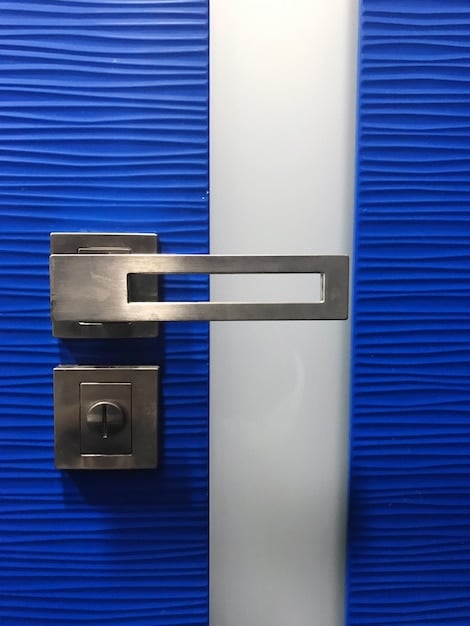Protect Your Home in 2025: Theft and Vandalism Guide

Protecting your home from theft and vandalism in 2025 requires a multi-faceted approach, combining advanced security technologies with traditional methods such as strong locks, reinforced doors, well-lit exteriors, and active community engagement to create a comprehensive security strategy.
As we approach 2025, safeguarding your home from theft and vandalism requires a proactive and informed approach. This guide, “How to Protect Your Home from Theft and Vandalism in the US: A Guide for 2025,” provides comprehensive strategies to enhance your home security.
Understanding the Risks: Theft and Vandalism Trends in the US
Understanding current trends in theft and vandalism is crucial for homeowners in the US. By staying informed about common targets and methods used by criminals, you can better prepare and protect your property.
Common Targets for Theft
Thieves often target specific areas and items within a home. Garages, sheds, and unlocked windows are prime entry points. Knowing this helps you reinforce these vulnerable spots.
- Electronics: Laptops, tablets, and smartphones are easy to resell.
- Jewelry and Cash: These are traditional targets due to their high value and portability.
- Vehicles: Cars and motorcycles parked outside are often targeted.
- Tools and Equipment: Power tools, gardening equipment, and bicycles are attractive to thieves.

Vandalism Hotspots
Vandalism can occur in various forms, from graffiti to property damage. Certain areas are more prone to these acts, making awareness essential.
- Exterior Walls and Fences: These are often targeted with graffiti.
- Gardens and Landscaping: Plants and outdoor decorations can be damaged.
- Mailboxes and Entrance Areas: These are easily accessible and often vandalized.
By understanding common theft targets and vandalism hotspots, homeowners can focus their security efforts on the most vulnerable areas. Regularly assessing your property and taking proactive measures can significantly reduce the risk of becoming a victim.
Upgrading Your Home’s Physical Security
Physical security is the first line of defense against theft and vandalism. Upgrading your doors, windows, and perimeter can deter criminals and make your home a less appealing target.
Reinforcing Entry Points
Strengthening your doors and windows is essential. Consider upgrading to more durable materials and installing high-security locks to prevent forced entry.
- Solid Core Doors: Replace hollow doors with solid core options for added security.
- Reinforced Door Frames: Strengthen door frames with metal plates to prevent kick-ins.
- High-Security Deadbolts: Install deadbolts with a longer bolt throw for enhanced resistance.
Window Security Measures
Windows are often overlooked but are a common entry point for burglars. Securing your windows can significantly improve your home’s overall security.
- Window Security Film: Apply a transparent security film to make windows more resistant to shattering.
- Window Sensors: Install sensors that trigger an alarm when a window is opened or broken.
- Window Bars or Grilles: Consider adding bars or grilles for added protection, especially on ground-level windows.
Upgrading your home’s physical security is a worthwhile investment. By reinforcing entry points and implementing window security measures, you can create a safer environment for your family and deter potential intruders. Regular maintenance and inspections are also crucial to ensure your security measures remain effective.
Investing in Smart Home Security Systems
Smart home security systems offer advanced features and convenience, allowing you to monitor and control your home’s security remotely. These systems can provide real-time alerts and deter criminals with visible security measures.
Components of a Smart Home Security System
A smart home security system typically includes several key components that work together to protect your home. Understanding these components can help you choose the right system for your needs.
- Security Cameras: Wireless cameras can be strategically placed indoors and outdoors to monitor activity.
- Motion Sensors: These sensors detect movement and trigger alerts or activate cameras.
- Smart Locks: Keyless entry systems allow you to control access to your home remotely.
Benefits of Smart Security Systems
Smart security systems offer numerous benefits beyond traditional alarms. These systems provide enhanced control, convenience, and peace of mind.
One of the most significant advantages is remote monitoring. With a smartphone or tablet, you can view live camera feeds, receive alerts, and control locks from anywhere in the world. This is particularly useful when you’re on vacation or away from home for extended periods.
Another benefit is the ability to customize your security settings. You can set specific rules for different times of the day, such as arming the system automatically at night or disarming it when you arrive home. Smart locks also allow you to grant temporary access to guests or service providers without having to issue physical keys.

Investing in a smart home security system is a modern and effective way to protect your home. By understanding the components and benefits of these systems, you can make an informed decision and create a safer living environment. Regular maintenance and updates are essential to ensure your system remains effective and secure.
Enhancing Outdoor Security
Outdoor security is often overlooked, but it plays a crucial role in deterring thieves and vandals. Well-lit exteriors, trimmed landscaping, and secure outbuildings can make your property less appealing to criminals.
Effective Lighting Strategies
Proper lighting can significantly reduce the risk of theft and vandalism. Install motion-activated lights and ensure all entry points are well-lit to deter intruders.
Motion-activated lights are particularly effective as they startle potential intruders and draw attention to their presence. Place these lights near doors, windows, and along pathways to illuminate any suspicious activity. Consider using LED lights for energy efficiency and longer lifespan.
In addition to motion-activated lights, ensure that all entry points, such as doors and gates, are well-lit. Use decorative lighting or floodlights to illuminate these areas. This not only enhances security but also makes it easier for you and your guests to navigate your property at night.
Landscaping for Security
Landscaping can be used strategically to enhance security. Trim shrubs and trees to eliminate hiding spots and ensure clear visibility around your property.
Overgrown shrubs and trees can provide cover for intruders, making it easier for them to approach your home undetected. Regularly trim these plants to maintain clear lines of sight from your windows and doors. Consider planting thorny bushes or shrubs near windows and along fences to deter 접근.
By implementing effective lighting strategies and landscaping for security, you can create a safer and more secure outdoor environment. Regular maintenance and attention to detail are essential to ensure your outdoor security measures remain effective.
Community Involvement and Neighborhood Watch Programs
Community involvement and neighborhood watch programs are valuable resources for preventing crime. By working together with your neighbors, you can create a safer and more secure community.
Benefits of Neighborhood Watch Programs
Neighborhood watch programs encourage residents to be vigilant and report suspicious activity. These programs can deter crime and improve communication among neighbors.
One of the primary benefits of neighborhood watch programs is increased vigilance. Residents are encouraged to keep an eye out for suspicious activity and report anything unusual to the police. This can help deter crime and provide early warnings of potential threats.
Neighborhood watch programs also foster a sense of community and improve communication among neighbors. Regular meetings and social events provide opportunities for residents to get to know each other और build relationships. This can lead to greater cooperation and support in times of need.
How to Start or Join a Program
Starting or joining a neighborhood watch program is a simple process. Contact your local police department or community organization for assistance.
The first step is to contact your local police department or community organization to inquire about existing neighborhood watch programs in your area. If there is already a program in place, you can attend a meeting and learn how to participate. If there is no program, you can work with the police department to start one.
To start a program, you will need to gather a group of interested neighbors and designate a coordinator. The coordinator will work with the police department to organize meetings, distribute information, and coordinate activities. It is important to establish clear guidelines and expectations for participants to ensure the program is effective.
By engaging in community involvement and participating in neighborhood watch programs, you can help create a safer and more secure community. Working together with your neighbors can deter crime and improve the overall quality of life in your neighborhood.
Insurance Coverage for Theft and Vandalism
Understanding your insurance coverage is essential for protecting your finances in the event of theft or vandalism. Review your policy and ensure you have adequate coverage for your belongings and property damage.
Types of Insurance Coverage
Homeowners insurance typically covers theft and vandalism, but the extent of coverage can vary. Review your policy to understand what is included and what is excluded.
Homeowners insurance typically covers damage to your property caused by theft and vandalism. This includes damage to the structure of your home, such as broken windows or doors, as well as damage to your belongings. However, the extent of coverage can vary depending on the specific terms of your policy. It is important to review your policy carefully to understand what is included and what is excluded.
In addition to coverage for property damage, homeowners insurance may also provide coverage for personal liability. This can protect you if someone is injured on your property or if you are held liable for damage to someone else’s property. However, personal liability coverage typically has limits, so it is important to ensure you have adequate coverage for your potential liabilities.
Filing a Claim
If you experience theft or vandalism, file a claim with your insurance company as soon as possible. Document the damage and provide accurate information to ensure a smooth claims process.
The first step is to contact your insurance company to report the incident and file a claim. Be prepared to provide information about the date and time of the incident, the nature of the damage, and any valuables that were stolen or damaged. It is also important to provide accurate contact information so that the insurance company can reach you easily.
Next, you will need to document the damage. Take photos or videos of the damage to your property and gather any relevant documents, such as receipts for stolen or damaged items. This will help the insurance company assess the extent of the damage and determine the amount of your claim.
Understanding your insurance coverage and knowing how to file a claim is essential for protecting your finances in the event of theft or vandalism. Review your policy regularly and ensure you have adequate coverage for your belongings and property damage. By being prepared and taking prompt action, you can minimize the financial impact of these unfortunate events.
| Key Point | Brief Description |
|---|---|
| 🚪Reinforce Entry Points | Solid doors, reinforced frames, high-security deadbolts. |
| 💡Enhance Outdoor Lighting | Motion-activated lights and well-lit entry points. |
| 🚨Install Smart Security | Wireless cameras, motion sensors, and smart locks. |
| 🤝Community Watch | Join or start a neighborhood watch program. |
Frequently Asked Questions
▼
Burglars commonly target front doors, back doors, and ground-floor windows. Securing these entry points with strong locks and reinforced frames is essential.
▼
Enhance outdoor security by installing motion-activated lights, trimming shrubs and trees, and securing outbuildings like sheds and garages to deter potential intruders.
▼
Smart security systems offer remote monitoring, customizable settings, and real-time alerts, providing enhanced control, convenience, and peace of mind for homeowners.
▼
Yes, most homeowners insurance policies cover theft and vandalism, but the extent of coverage can vary. Review your policy to understand what is included and what is excluded.
▼
Community involvement, such as neighborhood watch programs, encourages vigilance, improves communication among neighbors, and helps deter crime by creating a safer community.
Conclusion
Protecting your home from theft and vandalism in 2025 requires a comprehensive approach that combines physical security measures, smart technology, community involvement, and adequate insurance coverage. By implementing these strategies, you can create a safer and more secure living environment for yourself and your family.






